Food is a central activity of mankind and one of the single most significant trademarks of a culture. ∼ Mark Kurlansky
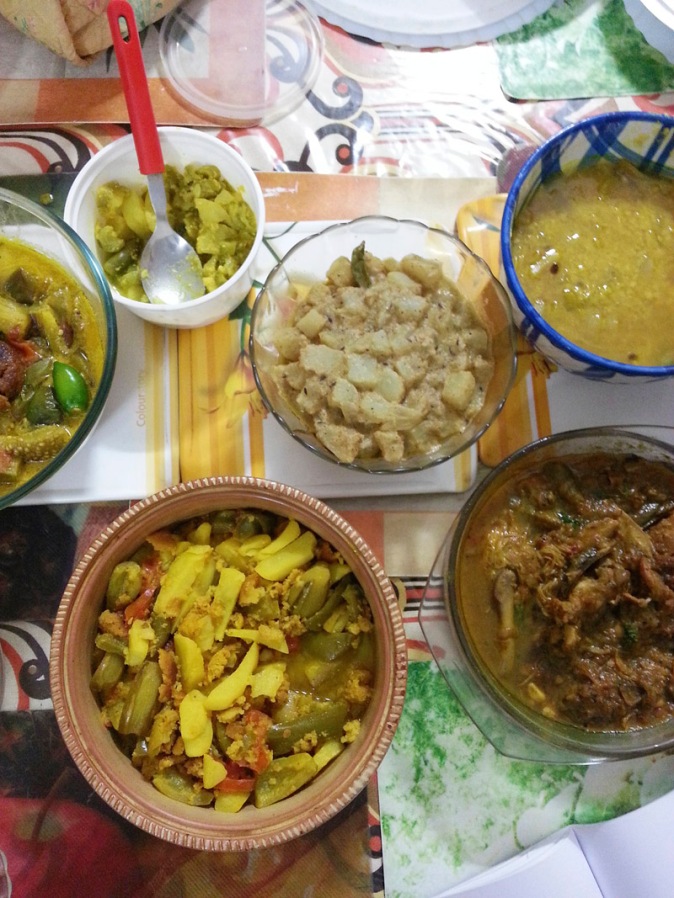
There was a time when finding a Bengali restaurant in Kolkata was difficult. It was limited to either the ‘no-frill canteen’ Suruchi or the ‘hotel restaurant’ Aaheli in Peerless Inn. And much later an inclusion of few Bengali dishes in the menu of Sonargaon in the 5-star ambiance of Taj Bengal. Suruchi is Kolkata’s first Bengali restaurant established in 1969 by the All Bengal Women’s Union and has been frequented by stalwart guests like Satyajit Ray. But it was, and still is, a no-frill joint serving good home-style Bengali food at a very reasonable cost. Toay, the tables have turned and there are innumerable good restaurants in the city that can make traditional home cooks (read my mum and mum-in-law) happy and serves a menu that boasts of traditional dishes that are becoming extinct even in the staunchest of traditional Bengali kitchens. These are not limited only to special delicacies but also regular dishes that once featured daily on our dining tables.

While Bengali food is gaining popularity, the cuisine itself is cerebral and much like French cuisine, has much layers to it, doling out in courses. Whether it is because of the elaborateness or naivety, Indian restaurants in India or outside India, still refer to either the North Indian cuisine – the Chicken Tikkas and Butter Chicken or the South Indian Dosas and Idlys… a culinary sabotage that necessarily happens when a country is vast with each region boasting of a strong and unique culture and cuisine.
How did the Kolkata dining scenario that typically boasted of ‘awesome’ Chinese and Awadhi restaurants and the stiff-lipped ‘Club Culture’ where Bawarchis specialised in Continental cooking suddenly change? Over the last few summers that I have spent in Kolkata, I have seen a surge of restaurants that serve traditional Bengali food not only from ‘this side of Bengal’, but also specialise in Bengali food from ‘that side of Bengal’ – the Dhakai cuisine from Bangladesh {Do read my encyclopedic post on Bengali Cuisine which also talks about the food and cultural conflict of Bengalis who have been torn by partition and comprise the two sides of Bengal – ‘this side – the Ghotis‘ and ‘that side – the Bangals‘… Traditional Bengali Cuisine | All The ‘Slight’ Details}. And most of these restaurants seemed to be doing a damn good job. The reasons probably are:
• The new generation Bengalis (just like in many cultures around the world) are not cooking at home so much. Recently, we got introduced to the owners of a Bengali restaurant in Gurgaon – Ki Hangla. We were told that working couples order plain daal, rice and jhirjhire aloo bhaaja/julienned potato fritters and coincides the delivery timing so that the hot food reaches them when they enter home. They are too busy/lazy even to warm the food in the microwave!
• The Bengalis are now taking pride in their own cuisine. While earlier dining out or a treat would necessarily mean indulging in other cuisines, it isn’t like that anymore. Across many cities in India, Bengali cuisine has become quite popular – Bangalore, Delhi and Mumbai. In fact, my friend and popular food blogger Kalyan Karmakar of Finely Chopped says that there are more Bengali restaurants in Mumbai than Maharashtrian restaurants prompting him to organise Bengali food walks in Bandra! While Bengali food is gaining popularity, the cuisine itself is cerebral and much like French cuisine, has much layers to it, doling out in courses. Whether it is because of the elaborateness or naivety, Indian restaurants in India or outside India, still refer to either the North Indian cuisine – the Chicken Tikkas and Butter Chicken or the South Indian Dosas and Idlys… a culinary sabotage that necessarily happens when a country is vast with each region boasting of a strong and unique culture and cuisine. At most there can be a Mustard fish preparation inspired by Bengal {In Chef Vineet’s Indego in Dubai, there is!}

Thankfully, in my mother’s kitchen or in my mum-in-law’s kitchen, Bengali food hasn’t died – the first picture reflecting a spread in my Ma’s home on a casual day! Although with the mothers aging and gradually lacking their earlier enthusiasm, many delicacies which require elaborate cooking – like Mocha/Banana Blossom, Thor/Banana Plant pith, Paturis/steamed preparations in leaves, various Chutneys and pickles, different types of sweet preparations like Pithe – these are rarities nowadays. Back in our home in Dubai, I do take a lot of pride in cooking traditional Bengali food, but not for everyday meals. Our annual Bijoya dinner {the picture of the food spread earlier was from a Bijoya dinner at home} comprises of paanch rokom bhaja/5 types of fries, khichuri {my Khichuri post here}, narkol diye cholar daal/Bengal Gram Lenti with fried coconut pieces, karai shuti diye bandha kopir torkari/cabbage with green peas, labra or chyachra or chechki/different kinds of vegetable ratatouille, niramishi mangsho/mutton cooked without onion and garlic, chatni, rasamalai etc {and jhalmuri and jhal aloor dum spicy aloor dum a la Vivekananda Park style to go with the drinks!}. When we have guests at other times, I try to stir up ‘Bengali inspired’ dishes – like the Mustard Salmon {the picture above with my quick recipe here} or the Shondesh Pudding {again my recipe here}. Interestingly, a pop up last year in a city restaurant was a testimony to how amazingly palatable Bengali food can be to non-Indian palates – of course under manipulated cooking!
The following are my top places to showcase Bengali cuisine in Kolkata, depending upon the demands of the occasion and there are new restaurants opening up in almost all locality and neighborhood – almost every month.

6 Ballygunge Place ∼ traditional food with a glimpse of Bengal’s culinary heritage
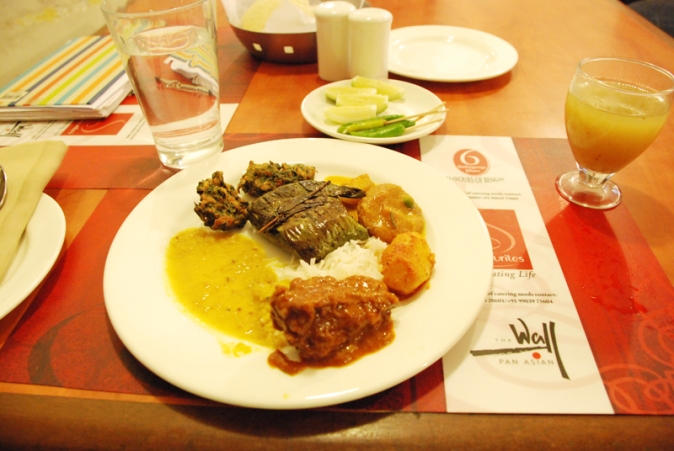
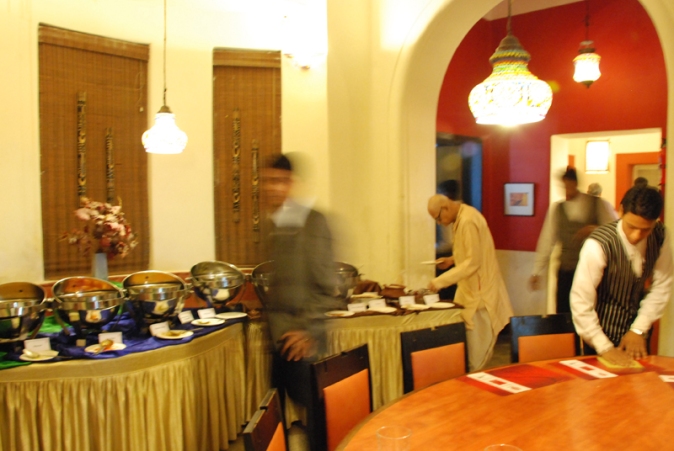


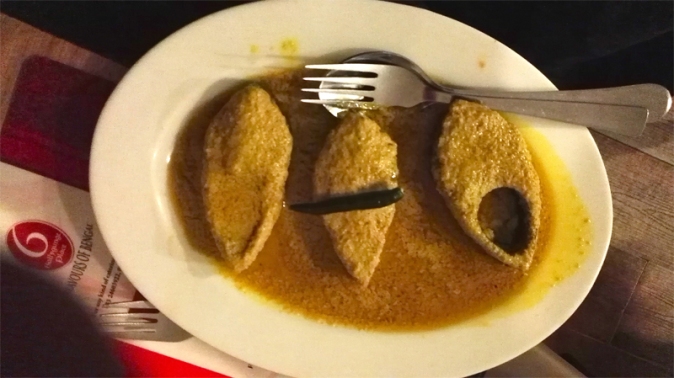
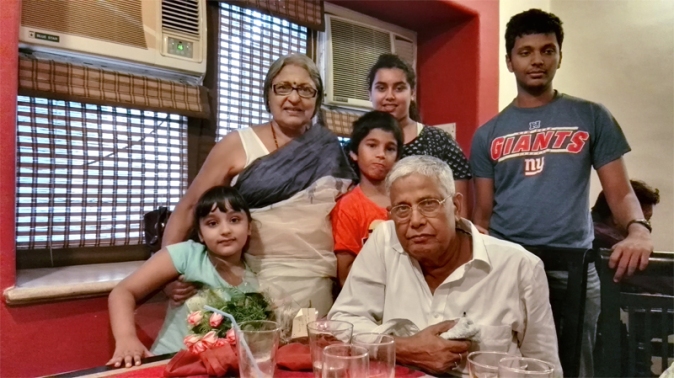
As the name suggests, 6 Ballygunge Place is the address where the white resplendent bungalow that once belonged to a former Rai Bahadur was converted into a restaurant in 2003 when there were still not many restaurants serving Bengali food in the city. The name has become a credible brand now with branches in other parts of the city and franchises in many other Indian cities. When I met the the founder-director of 6 Ballygunge Place – Chef Sushanta Sengupta two years back, he told me how his research involved cookbooks spanning different eras, including the cooking that took place in Thakurbari {the house of Tagores}, specially Pragya Devi Sundai’s recipes. She was a scion of the Tagore family, who used to write a column in a vernacular news paper on various recipes. That perhaps was the first column of its type in the end of 19th Century and the beginning of the 20th Century.
What do I love about the Menu? The menu is elaborate and boasts of many delicacies – the dishes are creatively named. The mocktails are named after famous streets in Kolkata – 3 Gour Mohan Chatterjee Street, 1/1 Bishop Lefroy Road {served as a residence to the legendary Satyajit Ray} and so on. The Aam pora Shorbot/smoked Raw Mango Sherbet and Gondhoraj Ghol/Lassi with Bengal Lime are available seasonally and probably have started the trend of traditional Bengali beverages in Bengali restaurants. From the elaborate Starters menu, here are my top picks {dishes which are painstaking to make at home!} – Chingrir Kabiraji Cutlet/Prawn mince cutlet fried with egg net batter, Hansher Deemer Devil/Duck egg crumbed croquettes stuffed with minced lamb, marinated and deep fried Gondhoraj Chicken strips, Mourala Maacher Peyaji/fritters of the delicate Mourala fish. For the Bhajas or Fries, the eternal favourites are jhir jhire Aloo Bhaja/julienned potato fritters and Posto Narkel Bora/ground poppy seeds and roasted coconut croquettes {although it always feels like just 4 boras in a plate are never enough and paying Rs 100+ again for another plate is also too much!}. From the Vegetarian section, the hard-to-make-at-home-dishes are always the repeat orders for this die-hard non-vegetarian foodie. Some of the dishes being – Dhokar Dalna/fried lentil cakes cooked in gravy, Pur Bhora Doi Potol/delicately stuffed wax gourds cooked in gravy, Mochar Ghonto/banana blossom balls cooked with potato in gravy, Echorer Dalna/unripe Jackfruit cooked in gravy and… the home-style Chanar Dalna/fresh made cottage cheese dumplings simmered in a tomato-yoghurt gravy. The choices from the Mains are too many – some highlights would be Galda Chingrir Chine Kabab/stuffed Jumbo Prawns, Daab Chingri/prawns cooked inside tender coconut or the Chingrir Malaikari/Prawn Curry cooked in Coconut Milk, Eilish Paturi/Boneless Hilsa wrapped in Banana leaf and grilled (deboning the Hilsa is not a mean feat), Chitol Maacher Muitha/Chitol fish dumpling cooked in gravy, Tel Koi/Koi fish cooked in Mustard oil, Kancha Lanka Dhone Pata Murgi/Chicken in green chillies and coriander. How do we sign off? This is one time when the Bengali fusion desserts are more attractive than the traditional ones – Nolen Gurer Icecream/icecream flavoured with season fresh date jaggery and the Baked Pantua.
When do we visit 6 Ballygunge Place? The interiors don’t resemble any restaurant and is more like a home. Every year we gather here – with immediate family members from both sides (mine and S’s) – and we occupy one of the inner rooms… even in our Kolkata visit this time, we celebrated my in-laws 48th marriage anniversary (picture above). Our choice on such occasions is to go for the grand Buffet that more or less suffices to reflect some of the more popular dishes from the wide spectrum of Bengali Cuisine – from Shaak to Mishti Doi and order a few delicacies from the a la carte to supplement what is missing in the buffet spread (like we did the Hilsa and the Bhetkis this time). {Excepting Sundays, buffets are available during lunch and are priced at Rs 450+/person, with the Saturday buffet offering a bit more (Aam Pana and 4 non-veg items instead of the regular and priced higher)}.
In recent times, 6 Ballygunge Place has set up a chain of “Thali” restaurants across Kolkata – in Behala, Kasba and Saltlake. The thali/platter offering the best of Bengali cuisine like fulko luchi, kasha mangsho, dhokar dalna, shukto, chatni, misti etc. For me it’s a great concept to bring Bengali food at reasonable prices {a veg thali is priced at Rs 175/person while a non-veg thali is priced from Rs 275/person}, although my parents who have actually tried in the Kasba outlet differ in their opinions. According to them if one adds on items, one ends up with a huge bill – so might as well visit the flagship restaurant and eat in a better ambiance {and dig into more food!}
Bhojohori Manna ∼ for unashamed and unabashed indulgence into traditional fare!
Bhajahori Manna is my absolute favourite and although there are many branches all over the city, I would still run to the tiny little garage space in Ekdalia Park where the first outlet rolled out from – even though it is crowded and there is long queue. Once we even had lunch in the Ekdalia outlet while the floor was submerged in ankle-deep water, with our legs folded up in our chairs. You don’t need to wait much – piping hot food is always getting prepared {and vanishing}. Started by 5 foodies that including our close family friend – the award winning director Goutam Ghosh, Bhojohori Manna has also developed into a credible brand and have franchises across other Indian cities. Named after the famous Bengali song rendered by Manna Dey in the 70’s, Bhojohori Manna had been the magical cook who travelled to different lands. The endeavour is to promote the old world concept of a ‘pice hotel’. The menu is handwritten every day on a whiteboard {no not the chalk arts that you might visualise in urban cafes!} and uses season fresh ingredients.
What do I love about the Menu? Almost everything! From the different types of ratatouille that the Bengali kitchen boasts of – Chyachra, Lyabra or the Maacher Matha Diye Ghonto {the latter cooked with fish head and fish bones} to simple home styled preparations of Postor Borar Jhal/fried balls of ground Poppy seeds cooked in gravy or the Panchmeshali Chochori – the five vegetable mishmash, the menu is really long and elaborate. Where else can one order Rui Macher Deemer Bora/croquettes of Rohu fish eggs – the caviar version of the Bengali variety! Also a lot of fish preparation comes with the availability of desi fish – desi Pabda, desi Tyangra, desi Parshe, desi Koi and even the Chara Bhetki. Other top picks are Potoler Dorma/stuffed wax gourd, Chingrir Bora and the various nitty gritties of preparations with fish head and fish bones – Muri Ghonto/Rice preparation with fish head and bones, Ilisher Matha Diye Pui Shaak or Kolmi Shaak/Basella leaves or Water Spinach with Hilsa Fish head, regular Bhetki Kata Chocchori. More than the chicken or the mutton preparations {although the special Dak Bungalow or the Goalando Steamer curry are tempting enough}, I think the highlight of the Bhojohori kitchen is all the fish preparations – Pabda, Parshe, Chitol, Iilish, Rui {even Gurjali Maacher jhaal} and the prawn and crab preparations, specially the regular features from home kitchens – the Desi Koi Aloo Phulkopir Jhol/Desi Koi with potatoes and cauliflower or Begun Bori diye Maacher jhol/fish preparation with lentil balls and eggplant. Talking about desserts, although the city is not short of any sweet shops, a few of these restaurants are keeping up with some of the intricate desserts that aren’t being made at homes these days. I prefer to sign off my meal at Bhojohori with Chandrapuli or Patishapta – something that is still not available in many regular sweet shops.
When do we visit Bhojohori Manna? While I wouldn’t be treating my heel-clad guests in the Ekdalia outlet, preferring the one in Hindustan Park, I myself will hop only into the Ekdalia outlet if I had to – I simply love the ‘two pice’ charm – the very essence with which Bhojohori started. Bhojohori Manna is for indulging as well as just digging into a piping hot traditional Bengali meal, quickly and on the go. Every time I pass by the Ekdalia outlet and see the uniformed security guard at the gate waiting to usher guests in {the only anomaly here with the simple ‘two pice’ canteen look of the tiny interiors}, I am tempted to just step in an sit down for an indulging meal!
Last heard, Bhojohori Manna is in talks to venture into Dubai – and I am guessing that it is not the ‘two pice’ concept but the rich heritage of Bengali cuisine that will be showcased {I will be the loudiest cheerleader once this happens!}
Bohemian ∼ food that does cabaret on the senses with trusted flavours from Bengal but in a new appearance!
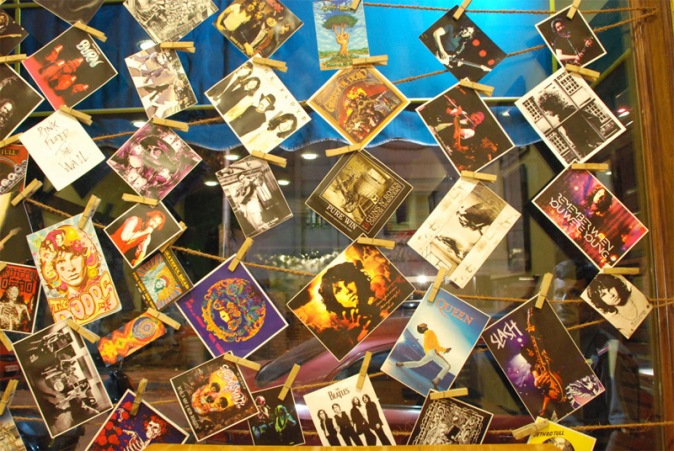


Bohemian is another place that has come up recently on the city’s culinary radar {Do read my review on Bohemian and an interview I took of Chef Joymalyo}. Please don’t expect the traditional Luchi, Aloor Dum and Cholar Daal here {although my brother ordered exactly that!}. Gondhoraj Lebu Sorbet & Gondhoraj soufflé, Vegetable Monihari with tender Coconut & Gondhoraj Lebu, Prawn Gondhoraj, Bhetki Gondhoraj dance on the senses and the food is exotic fine-dining although I wouldn’t describe the ambiance as fine-dining – its more like a causal cafe restaurant. Chef Joy has been the head Chef of Oh! Calcutta and has a pretty credible name. Chef Joy’s words rings in my ears – ‘“Smoking, pan grilled – these are not traditionally Bengali cooking techniques. Nor are the desserts traditionally Bengali – the Mousse or the Soufflé. But the spices used are all Bengali Moshla/Spices. The fresh produce is locally sourced and very indigenous.’
Recently, Bohemian has had a change in its menu and I haven’t yet the chance to taste it. So my comments here are naturally based on its earlier menu but I have this feeling that the experience from the new menu wouldn’t be much different.
What do I love about the Menu? The Panch Phoron laden food of course! What makes the Bohemian menu intriguing is the amalgamation of flavours. And the use of distinctly Bengali flavours and spices in it’s non-traditional cooking. There’s an element of surprise in each and every dish that is served. Maybe not so surprising for someone who’s not aware of Bengali food. But for a Bengali, to find his/her favourite dish with an international twist or an international dish laden with unique Bengali spices like Panch-phoron/5 Spice Mix is definitely a novelty. Our pick from the Starters – Panch Phoron flavoured Chicken Escallops, Vodka soaked Prawns with Grilled Garlic Aioli, Joyous Mutton Chops (above left in the 2nd row) and Chilli Pickle n Cheese baked Crab with Kolmi Greens (in the last row in the above picture). The definite must-try would be the palate cleansers – Green Mango & Honey Sorbet, Orange & Aam Adaa Sorbet, Gondhoraj Sorbet. For the Mains, my picks are Daab aar Gondhoraj Diye Shabji-r Monihari/vegetable with coconut & gondhoraj lime, Phoolkopir Malai Curry/cauliflower malai curry, Pabda Rolls stewed in cherry tomato & spinach broth, Panch Phoron flavoured Parshe with smoked green chilli sauce, Grilled Bhetki with Bengal Berry Sauce, Bacon baked Tilapia with ginger & fennel and Prawns with muddled grapes & chillis. In meat items, my pick will be Spicy Pork Curry (cooked with Anglo-Indian spices), Royal Bengal Roast Mutton with Bhuna Sauce, Mutton Vindalaoo (Calcutta style), Ham Steak – Chef Joy’s style. Again the desserts border on fusion – Malpua Cheese Cake, Gondhoraj Soufflé, Spiced Mango Soufflé, Mustard and Tender Coconut Mousse, Channa Panch Phoron Mousse.
When do we visit Bohemian? When we want to surprise our senses to what ‘new’ is being served which has the flavours of Bengali cuisine. Definitely not for those who want a showcase of traditional Bengali food but definitely for those who are in love with great tasting gourmet food. Also definitely not when you don’t want to splurge. The bill is high which probably accounts for the novelty of the menu but not the ambiance. The new menu just like it’s earlier counterpart is intriguing and interesting – and like the earlier menu is elaborate and calls for return visits just to ‘cover’ it… the Guava and Rock Salt sorbet as palate cleanser or the Toffee Roshogolla and the Pantua Baked Alaska! My belief is on the Chef himself – and I would like to congratulate him on the ‘bohemian’ and Rancho-inspired track he is on to re-invent himself, of course flavoured with Bengali spices!
Last heard, Bohemian has changed its menu and a few of my foodie friends who are Bohemian fans are a bit disappointed. I am yet to taste the new menu. Last year on my summer visit to Kolkata however, we chose Bohemian over 6 Ballygunge Place for our annual family grand-get together. The upper level was yet to open but the Chef opened it just for us {yes, I believe a lot of people have come to Bohemian – specially from Dubai, after reading my review} and we were pampered to the hilt. As usual, Bohemian didn’t disappoint us – neither our mothers – which is the toughest litmus test!
Oh! Calcutta ∼ an oft visited place in yesteryears, but now lies as the forgotten pioneer in my book. I keep reminding myself once in a while that the bill is lesser than Sonargaon in Taj Bengali and the menu more authentic!

Neglected in my book at this hour and day when traditional Bengali food is available at many places and at half the bill, I have to admit that it was Oh! Calcutta which first started this new chapter of serving traditional Bengali food in. Continuing with Chef Joy’s conversation – ‘Even a few years back, there were not many restaurants serving Bengali food. Bengalis, in general, didn’t have the inclination to eat Bengali food when they went out to eat. Not many believed that a Bengali restaurant could be made commercially viable. Here, the contribution of Oh! Calcutta has been huge.’ However, like Anjan Chatterjee’s other restaurant Mainland China, Oh! Calcutta has had a phenomenal growth across the city as well the country and I still remember the excitement of eating traditional Bengali fare in a wood panelled elegant ambiance with customised plates at its flagship outlet at Elgin Road. But I detest the crowd and the long queue of Oh! Kolkata in shopping malls, however popular the buffets might be or however attractive the a-la carte menu is priced at.
What do I love about the Menu? I think I had my first Boneless Hilsa and the Bhetki Maacher Paturi/Bhektki fillets marinated and wrapped in banana here. Or the Vodka Aam Pana. My top picks are Aam Kashundi Kakra/Crab cooked with Mango and Mustard, Chitagong Masala Murgi/Chicken cooked in Chitagong style, Kacha Lanka Murgi/chicken cooked with green chillies and coriander, Kasha Mangsho/Lamb pot roasted with potatoes and thick gravy. No special desserts to choose from the menu though.
When do we visit Oh! Calcutta? When I have to showcase Bengali food to my non-Bengali and non-Indian friends with some fine wine accompanying my Bengali food – it will have to be Oh! Calcutta at the Silver Arcade on Bypass. The bill is still lesser than Sonargaon in Taj Bengali and the menu more authentic! I would challenge the team to however reinvent itself – I would like to see how a Chochori or a Chyachra can be served in a fine dining manner {no fusion here please!}
Last heard, Anjan Chatterjee had been in talks to open one of his flagship restaurants in Melia Dubai – when I had interviewed Chef Sanjeev Kapoor, he said that he had requested AC to open a restaurant in Dubai and he was contemplating bringing in Mainland China over Oh! Calcutta – sigh:(
Here and there ∼ it’s not the end of the road, but almost all roads lead to a Bengali Restaurant in the city today!

Kasturi Restaurant (est 1994): Recently, we had lunch {the evidence is as above} at the outlet near Patha Bhavan and our experience was fabulous. The menu is elaborate and claims that it serves Dhakai cuisine, but apart from a few Bhortas, I felt that the stress is more on the Bengali cuisine from this of Bengal. I had ordered a Sampoorna Bhoj with prawn and it came with Moong Dal, Jhur Jhure Allo Bhaja, Aloo Posta and more. We had also ordered their signature Kolmi Shaak diye Chingri/prawn paste with water spinach – a taste that perhaps is going to bring me back. But if my sole focus was on good traditional Bengali food with no preference of any ambiance or lack of elbow space, I would rather hop into the Ekdalia outlet of Bhojohori Manna. If my focus is on a bit of an ambiance I would go to 6 Ballygunge Place. A bit of emphasis on the interiors may help – why keep a statue of an Egyptian figurine on the shelf when it is all about Bengali food?
Kewpie’s Kitchen (est 1989): This is one legendary place located at one legendary house – Minakshie Dasgupta’s house. Starting off as a 12-seater eatery in the garage of the house, today the entire house has been converted into a restaurant. A lot of recipes are from Minakshie Dasgupta’s famous books “Bangla Ranna” & “Calcutta Cookbook”. Today, her daughters Rakhi Purnima Dasgupta and Piu Purnima Dasgupta run the restaurant and it is pretty much a pleasure when the former is around to explain the dishes served to the guests. The interiors are more eclectic than 6 Ballygunge Place as this has been a formally lived in space for its celebrated owners and is always filled with foreign guests, students and others who are interested in learning more about Bengali Cuisine. Rakhi Purnima Dasgupta occasionally imparts cooking classes here in collaboration with a market walk with Iftekhar Ahsan of Calcutta Walks {here’s my experience of one of my walks with them} that follows a lunch experience in Kewpie’s Kitchen. Again the menu has its fair share of Ghonto and Maacher Jhaal, but the charm is having the food in specially designed clay thali/plate and batis/bowls. Although my last visit to Kewpie’s hasn’t been all that great, I do recall fond times at Kewpie’s much before the times of SLR and smartphones – when we dined out without the intention of taking selfies first or Facebook updates!
Here, I have listed ‘my one-stop culinary destination for Bengali food’ under different circumstances. A discussion on the topic with foodie friends on Facebook resulted in a lot of names – the list is long and not comprehensive though… Rajbarir Khao, Bhooter Raja Dilo Bor, Sholo Ana Bangali, Panch Phoron, Dhaka Puran, Radhuni and Prince in Free School street, Byloom with a small menu, Padmaparer Rannaghar, Kashe Kasha and more. Do live in a city where your regional cuisine is well represented and do you think that traditional kitchens are dying?
Unblogging it all… Ishita
Disclaimer: Thanks Anindyo, Kaniska, Kalyan, Monalisa, Sumitava, Jayita, Mamta, Milon and others for joining in the discussion. All meals have been paid from my own pocket. The subject, story, opinions and views stated here are my own and are independent. While you enjoy reading my posts with lot of visuals, please do not use any material from these posts. Do join me on my daily food and travel journey on Instagram, Facebook and Twitter.


Have not tried a lot of these places yet….got to list these down for the next trip to Kolkata! Thanks.
LikeLike
Wait to hear your feedback… and probably by your next trip there will be more to add up to the list!
LikeLike
Bhajahori Manna any day, all day please!!
LikeLike
For us too! Digging into the food – kobji dubiye would be the word!
LikeLike